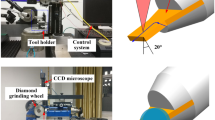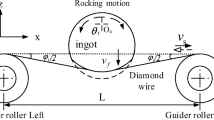Abstract
As an essential beam-splitting component in the beamline station of synchrotron radiation sources, the channel-cut crystal serves to improve reflectivity, collimation, and stability of the X-ray beam emitted from the synchrotron radiation source. However, a major limitation to the implementation of the channel-cut crystal is polishing its narrow channel. To resolve this problem, a novel chemical mechanical polishing motion pattern is proposed. In addition, a relative motion model between the workpiece and the polishing plate is established, the equation of the trajectory of the abrasives relative to the workpiece is derived, the effects of multiple factors such as motion cycle ratio between the workpiece and the polishing plate are analyzed, and eccentric radius on the relative motion trajectory is analyzed too. Furthermore, by identifying the effects of the polishing trajectory, the polishing solution concentration and polishing pressure on the polishing results were explored, and the mirror polishing of the inner surface of the narrow channel of the channel-cut crystal is realized successfully. The proposed motion patterns of CMP can be applied to polish narrow structures of hard and brittle material (e.g., silicon, glass).











Similar content being viewed by others
Abbreviations
- l 1 :
-
Length of workpiece (cm)
- h 1 :
-
Height of workpiece (cm)
- l 2 :
-
Length of polishing plate (cm)
- h 2 :
-
Height of polishing plate (cm)
- v :
-
Speed of horizontal reciprocating motion (cm/min)
- d :
-
Distance of horizontal reciprocating motion (cm)
- ω :
-
Rotation speed of electric cylinder rotation (r/min)
- r :
-
Rotational radius (cm)
- T 1 :
-
Time of the horizontal motion cycle (min)
- T 2 :
-
Time of the rotational motion cycle (min)
- k :
-
Motion cycle ratios
References
Lv Z, Huang CZ, Zhu HT, Wang J, Hou RG (2018) A 3D simulation of the fluid field at the jet impinging zone in ultrasonic-assisted abrasive waterjet polishing. Int J Adv Manuf Technol 87(9-12):3091–3103
Han YJ, Zhang L, Fan C et al (2018) Theoretical study of path adaptability based on surface form error distribution in fluid jet polishing. Appl Sci (Basel) 8(10):1814
Chai Y, Li RW, Perriman DM, Chen S, Qin QH, Smith PN (2018) Laser polishing of thermoplastics fabricated using fused deposition modelling. Int J Adv Manuf Technol 96(9-12):4295–4302
Krishnan A, Fang FZ (2019) Review on mechanism and process of surface polishing using lasers. Front Mech Eng 14(3):299–319
Su X, Ji P, Liu K et al (2019) Combined processing chain for freeform optics based on atmospheric pressure plasma processing and bonnet polishing. Opt Express 27(13):17979–17992
Zhong B, Wang CJ, Chen XH et al (2019) Time-varying tool influence function mode of bonnet polishing for aspheric surfaces. Appl Opt 58(4):1101–1109
Wang YQ, Yin SH, Hu T (2018) Ultra-precision finishing of optical mold by magnetorheological polishing using a cylindrical permanent magnet. Int J Adv Manuf Technol 97(9-12):3583–3594
Pan JS, Yan QS (2015) Material removal mechanism of cluster magnetorheological effect in plane polishing. Int J Adv Manuf Technol 81(9-12):2017–2026
Chen GP, Luo HM, Kang CX et al (2019) Application of surface analysis in study on removal mechanism and abrasive selection during fused silica chemical mechanical polishing. Surf Interface Anal 51(5):576–583
Xue DB, Wang P, Jiao LY et al (2019) Experimental study on chemical mechanical polishing of chalcogenide glasses. Appl Opt 58(8):1950–1954
Kumar CR, Omkumar M (2019) Optimisation of pprocess parameters of chemical mechanical polishing of soda lime glass. Silicon 11(1):407–414
Ban XX, Zhao HY, Zhu XL et al (2018) Improvement and application of pad conditioning accuracy in chemical mechanical polishing. Opt Eng 57(9):095102
Kasman E, Montgomery J, Huang XR et al Strain-free polished channel-cut crystal monochromators: a new approach and results. Proc SPIE 10387:103870F
Funding
The work was financially supported by the National Natural Science Foundation of China (51875413, 51105279).
Author information
Authors and Affiliations
Corresponding author
Additional information
Publisher’s note
Springer Nature remains neutral with regard to jurisdictional claims in published maps and institutional affiliations.
Rights and permissions
About this article
Cite this article
Wang, K., Li, W., Qu, Q. et al. Chemical mechanical polishing of the narrow channel of a channel-cut crystal. Int J Adv Manuf Technol 108, 1691–1700 (2020). https://doi.org/10.1007/s00170-020-05443-2
Received:
Accepted:
Published:
Issue Date:
DOI: https://doi.org/10.1007/s00170-020-05443-2




